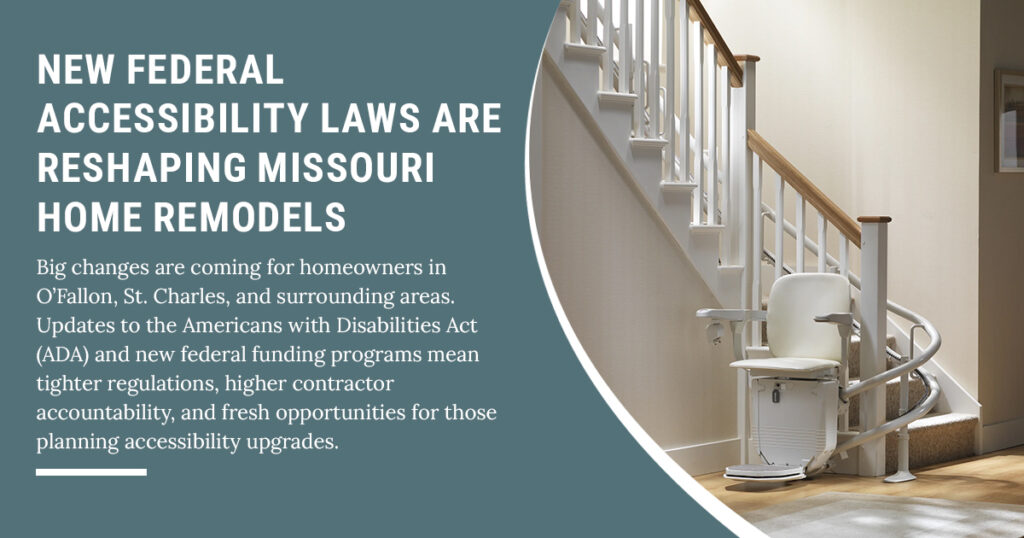
New Federal Accessibility Laws Set to Reshape Home Remodels in Missouri — What Homeowners Need to Know
If you live in O’Fallon, St. Charles, or surrounding areas in Missouri, big changes are coming to home accessibility standards that could affect your renovation plans. Recent updates in the Americans with Disabilities Act (ADA) and new federal funding programs mean tighter regulations, increased contractor liability, and opportunities for homeowners who plan ahead.
What’s Changing in Accessibility Regulations
The U.S. Department of Justice has recently clarified updates to ADA requirements and building accessibility in residential remodels, particularly those with public transit or visitor-use components. Key areas include ramp slope standards, door width minimums, barrier-free shower design, and required clearances in corridors. Missouri is among the states updating its own residential remodeling codes to more closely align with these federal shifts.
How These Changes Impact Missouri Homeowners
For many residents of St. Charles County and St. Peters, this means that projects involving handicap ramps, walk-in tubs, or barrier-free bathrooms will need to adhere to stricter compliance. Homeowners may see additional permit costs or required inspections, and contractors will need to ensure designs meet new slope/grading, safety, and material use standards.
Opportunities in New Federal & Local Funding Programs
Alongside the regulatory changes, there are new funding and grant opportunities available — especially for seniors, veterans, or disabled individuals looking to retrofit their homes. Programs through HUD and Missouri’s state housing agencies are offering subsidies or matching funds for compliant accessibility improvements. If timed right, homeowners can benefit from both improved accessibility *and* financial incentives.
What Homeowners Should Do Before Starting a Remodel
- Check whether your area (O’Fallon, Chesterfield, etc.) has adopted the newest ADA-aligned residential codes.
- Consult with contractors familiar with handicap remodeling—look for those with experience in barrier-free shower, ramp, lift installations.
- Explore grant/funding programs early — some require applications well before construction begins.
- Measure and document your household’s accessibility needs (mobility, aging in place, future proofing) to guide design decisions.
- Incorporate universal design principles even if not strictly required — wider doorways, non-slip surfaces, zero-threshold entries help long-term usability and resale value.
How Accessibility Home Improvements Is Preparing for the Shift
At Accessibility Home Improvements, we’ve already begun updating our design and construction processes to meet the new standards. Whether installing ramps, barrier-free showers, or walk-in tubs, we work closely with clients to ensure compliance, safety, and comfort. Our team stays current on permit requirements in municipalities like O’Fallon, St. Peters, Creve Coeur, and others to help homeowners avoid delays and extra costs.
Conclusion
The regulatory landscape for accessible remodeling is shifting quickly. Homeowners who plan now — checking local code changes, seeking funding, and working with experienced contractors — will save time, money, and stress. Accessibility isn’t just about meeting legal standards; it’s about creating safer, more usable homes now and into the future.
Thinking of adding accessibility features to your home? Contact us at Accessibility Home Improvements to schedule a consultation and ensure your remodel plans align with the latest standards in St. Charles County and nearby Missouri areas.
 Leave us a Google Review Here
Leave us a Google Review Here